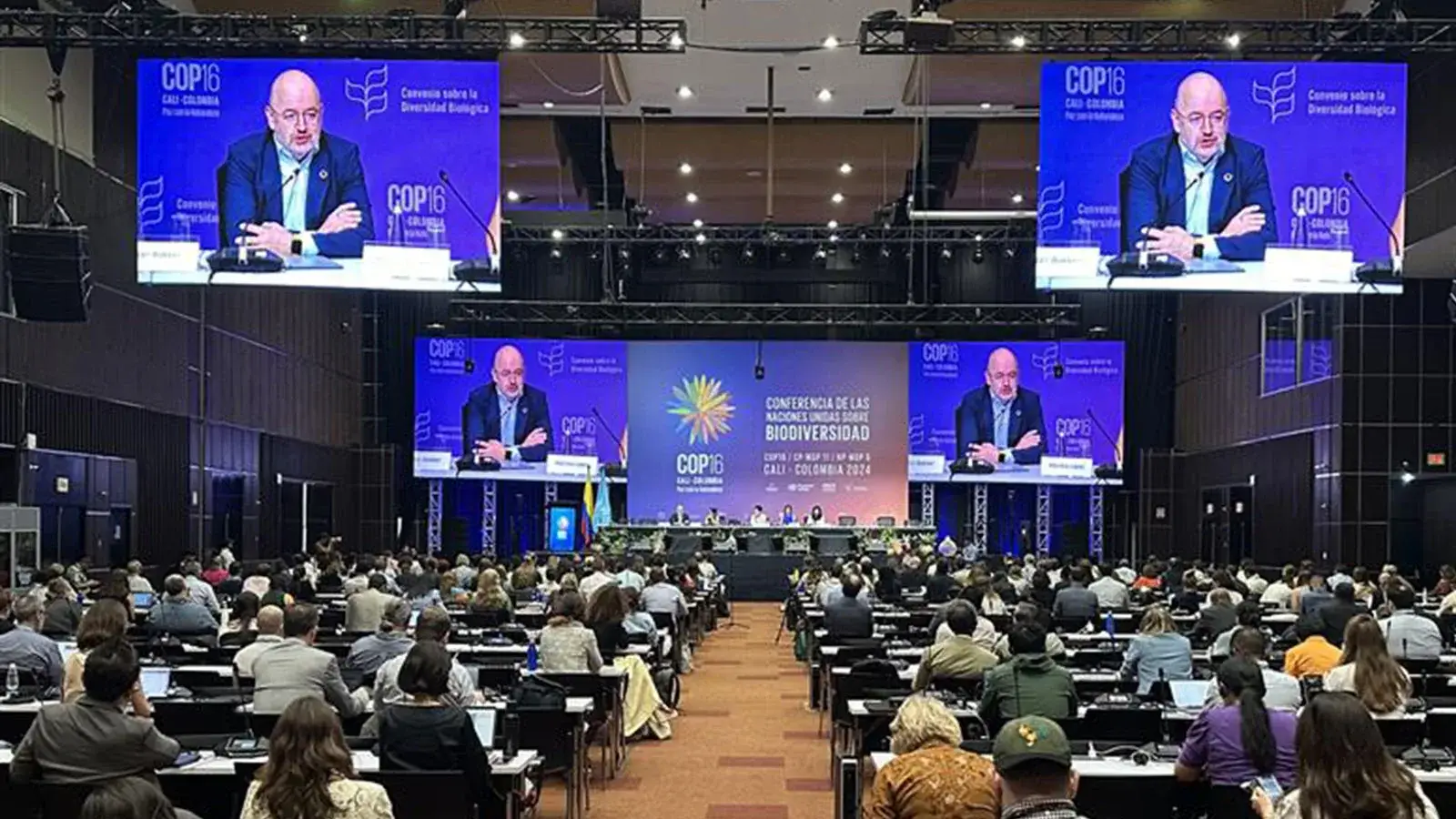Authors
Josip Pervan
CBD COP16 in Cali, Colombia, hosted a record attendance of around 23’000 people, with 3’000 representatives from the business community among them. As promised by Colombia, it was a true “People’s COP” with more than 1 million people participating in the event’s Green Zone located in the city’s centre. This increased popularity of “the Nature COP” drew political attention and observed familiar sticking points from other multilateral processes (such as financing) reappearing throughout the negotiations.
While we can celebrate some achievements, namely the groundbreaking decisions on benefit-sharing from genetic resources and the inclusion of Indigenous Peoples, the discussions were halted in the early hours of Saturday, 2 November, well past the conference deadline. The main point of contention between delegations was financing, which are evident in the outcome documents. These open issues are planned be addressed at the upcoming inter-sessional meetings in 2025.
Meanwhile, only 44 countries out of 196 member states submitted their National Biodiversity Strategies and Action Plans (NBSAPs) by the end of the COP, with 119 of them reporting on their National targets (a step before constructing NBSAP). The final decision from the conference urged countries to speed up the process of NBSAPs submission and the Global Environment Facility (GEF) to provide financial support to eligible countries (often quoted argument for failing to come up with NBSAPs by the Global South countries).
Bold action is needed from governments in 2025 to ensure more meaningful commitments on NBSAPs and implementation, and goodwill to agree on outstanding items during intercessional work. This could lay the groundwork for success at COP17.
Recap of key decisions taken:
- Digital Sequence Information (DSI) – Businesses in sectors utilizing genetic resources (pharmaceuticals, cosmetics, agriculture) will be required to contribute a percentage of their profits or revenue to the Cali Fund, a global fund for benefit-sharing. However, these contributions are not mandatory (at least for now).
- Subsidiary Body on Article 8(j) – The establishment of a permanent subsidiary body for Indigenous Peoples and local communities (IPLCs) strengthens their role in decision-making processes related to biodiversity.
- Mainstreaming Biodiversity – The conference emphasized integrating biodiversity considerations across various sectors, including agriculture, forestry, fisheries, and infrastructure. WBCSD helped design and signed a Call to action before the Conference, supporting such an outcome.
- EBSAs – The adoption of modalities for describing and modifying Ecologically or Biologically Significant Marine Areas (EBSAs) will impact businesses operating in marine environments, potentially leading to new conservation measures and restrictions.
- Linkage between the climate crisis and biodiversity loss – There was agreement on the interdependence of issues like climate change, biodiversity loss, pollution, and ocean acidification, and the need to urgently address these issues. In addition, better alignment of NBSAPs with countries’ Nationally Determined Contributions (NDCs) under the Paris Agreement will be expected. During the Conference, WBCSD joined other business, indigenous, civil society leaders in co-shaping and co-signing the open letter to Presidents Petro and Lula as hosts of CBD COP16 and UNFCCC COP 30 to call for a united action on climate, nature and food transformation for the benefit of the people.
- Capacity Building and Knowledge Management – Decisions on capacity building and knowledge management emphasize the importance of technical and scientific cooperation to developing countries and their companies. This presents opportunities for businesses to engage in partnerships and contribute to knowledge-sharing and technology transfer initiatives.
A summary of unresolved issues and uncertainties:
- Financial Mechanism – Disagreements on establishing a new global financing instrument for biodiversity leave uncertainties about future funding mechanisms and potential financial obligations for businesses.
- Resource Mobilization – The lack of agreement on resource mobilization strategies creates uncertainty about the level of financial support for biodiversity conservation and the role of the private sector in contributing to these efforts.
- Discussions on the planning, monitoring, reporting, and review (PMRR) mechanisms – Failure to reach full agreement before the talks were suspended. This is a key issue, as these mechanisms would establish the procedures for global reviews of collective progress on the GBF targets. One sticking point was the debate over which specific indicators to include, particularly around indicators related to land tenure for Indigenous Peoples and local communities. This was seen as a major win, as it will make land tenure a mandatory “headline” indicator. However, other indicator-related issues like those around pesticides, global consumption, and global footprint remained unresolved and bracketed in the text.
- Budget – The failure to adopt a budget for the CBD Secretariat raises concerns about the continuity of its operations and potential impacts on the implementation of the GBF.
More details on the negotiations can be found here.
Implications for the negotiations towards the COP 30
At COP29 in Baku, debates around the finance structure are likely to reflect the same tensions seen at COP16, particularly regarding how to balance funding commitments between developed and developing nations. Models of private sector engagement could offer valuable insights into these discussions, although the persistent North-South divide may complicate negotiations further. Looking ahead to COP30 in Belém (Brazil), the representation of Indigenous and local communities will be crucial, especially given the central focus on the Amazon, where biodiversity and climate change are deeply intertwined. Brazil’s position on issues like double-counting carbon credits and securing financial commitments will play a significant role in shaping outcomes, while lessons learned from implementing the DSI fund will also be important. Additionally, the intersection of health and environmental issues may emerge as a key theme.
The bioeconomy will play a central role at COP30, particularly as it aligns with the country’s focus on leveraging biodiversity to drive sustainable economic growth while preserving the Amazon. By creating value from natural resources through sustainable practices, Brazil aims to demonstrate how the bioeconomy can reduce poverty, reduce biodiversity loss and promote climate resilience. This approach is already gaining traction in international forums like the G20, where principles for integrating bioeconomy into global climate and nature strategies are being developed. These discussions are likely to influence earlier negotiations, such as at COP29, where the bioeconomy could be framed as a key solution for balancing economic development with environmental conservation.
Implications for the business community
COP16 signals a growing momentum towards integrating biodiversity considerations into all sectors of the economy and society. Businesses will face increasing pressure to adopt nature-positive practices, disclose their environmental impacts, and contribute to conservation efforts. Businesses will increasingly be expected to account for and address their impacts on both climate and nature in an integrated manner. Aligning corporate strategies, targets and reporting across these interrelated challenges will be crucial. In that context, investing in NbS can provide dual benefits for biodiversity conservation and climate resilience.
While the new benefit-sharing mechanism for DSI and the inclusion of IPLCs present challenges, they also offer opportunities for businesses to engage in responsible innovation and contribute to a more sustainable and equitable future. Businesses operating in areas with Indigenous populations will need to prioritize prior, and informed consent and ensure respect for traditional knowledge. It is foreseen that governments will advance their efforts to notify national targets and revise their NBSAPS. This poses an opportunity for companies to forge partnerships with governments and advance conservation efforts and innovation in their value chains.
The unresolved financial matters, however, create uncertainties and highlight the need for continued dialogue and collaboration between governments, businesses, finance and civil society to ensure adequate resources are mobilized to address the biodiversity crisis. Companies may also benefit from engaging with existing biodiversity finance mechanisms, including green bonds or payment for ecosystem services (PES) schemes.
Adapting to this evolving landscape and incorporating nature deeper into the companies’ portfolios and strategies will become increasingly important. Companies that do this stand to gain from mitigated risks, increased competitiveness, and building a future-proof operational model.
All in all, COP16 demonstrated an overwhelming agreement from business that the climate and nature agendas must be one integrated agenda. Supported through the definition of nature-related metrics and transparency, nature must now be put on the balance sheet, ensuring its value is embedded into the economic system.
Outline



